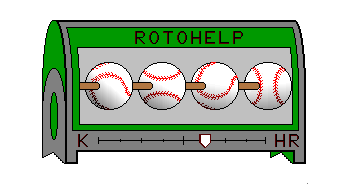|
|
||
 |
||
|
|
|
|
|
|
|
|
|
|
|
|
|
|
March 18th 2003 |
|
|
Out of the Frying Pan |
|
|||||
|
|
|
|||||||||
|
|
|
|||||||||
|
|
|
|
|
|
|
|
|
|
|
| |
|
|
|
|
|||||
|
|
|
by Jessica Polko Toronto took action on Monday to insure that their rebuilding plan will not be thrown off by a sudden escalation in the price of either Eric Hinske or Vernon Wells. The Blue Jays signed Hinske to a five-year, $14.75M contract. Meanwhile, Wells signed a five-year, $14.7M deal. In exchange for assuming the risks that either Hinske or Wells suffers a serious injury or sudden loss of production, the Blue Jays have secured them for the next five seasons at prices that should be significantly below what they would earn if the contracts were negotiated annually. I'm sure that both contracts are insured, so they probably only need to worry about production decline and not injury. Hinske and Wells were willing to agree to the deals, because they want to be a part of the growth of the team and didn't want to worry about the money issues. While they likely could have earned more now, if everything goes as planned, they'll both have an opportunity to sign bigger contracts in the future. These contracts insure neither should have to worry about money ever again regardless of how they perform over the next few years. Toronto drafted Vernon Wells out of high school with the 5th overall pick of the first round of the 1997 draft. He spent the remainder of that season at St. Catharines in the Short-Season New York-Pennsylvania League, and then advanced to A Hagerstown in the South Atlantic League for the 1998 season. Wells spent the majority of 1999 at A+ Dunedin in the Florida State League, but at that point, the Blue Jays started moving him quickly. He skimmed through AA and AAA, making his major league debut on August 30th at home against the Twins. Toronto wisely sent him back to the minors for the majority of the 2000 season with a brief major league call-up. However, as he only had around a 100 at-bats at AA, he struggled somewhat in his season at AAA and returned to AAA Syracuse for the majority of the 2001 season. Last year was Wells' first full season in the majors. While he maintained a promising walk rate through 2000, he began walking less in his second season of AAA and could improve his game by regaining some of his past patience. The 24-year-old possesses solid power skills that should continue to develop as he matures physically. He also has some speed, but he hasn't been overly successful on the basepaths, so I don't expect the stolen base to become a big part of his game. Wells isn't going to be a superstar, but he should be a solid regular and in the top half of centerfielders in the league through the end of this contract, which takes him through his arbitration years and to free agency. Toronto doesn't currently possess any prospects that should be knocking on the major league centerfield door in the next few seasons, and if they do develop someone before the end of the deal, Wells should be very tradable. Reportedly, Wells will receive a $350,000 salary in 2003, $700,000 in 2004, $2.9M in 2005, $4.3M in 2006, and $5.6M in 2007, as well as an $800,000 signing bonus. We took a thorough look at Hinske's background when he won the 2002 Rookie of the Year. His contract reportedly breaks down into $500,000 in 2003, $800,000 in 2004, $3M in 2005, $4.325M in 2006 and $5.325M in 2007 with a $500,000 signing bonus. Hinske appears to have a bit more power upside than Wells. He's also already displaying a strong walk rate, which means he doesn't have that easy route to additional production. Hinske's avenue to advancement seems to lie in improving his contact rate, though he's a better than average regular without any improvement in his skills. The 25-year-old probably has less raw speed than Wells, however he has good instincts on the bases and will likely run more as a result. He should receive All-Star consideration throughout this contract. Additionally, Toronto has no one in the system who should seriously challenge him for the starting third base job. The only complaint I have about either of these contracts is that both end when the players will logically first earn free agency. When contracts end in conjunction with a player first qualifying for free agency, players appear to feel more inclined to test the market. In Wells' case, I likely would have gone with one less year in order to give myself a season to negotiate another multi-year deal if I was interested in retaining him. With Hinske, I would have tried for an option on his first year of free agency, which would have again provided a negotiating period. Roy Halladay reportedly is the Blue Jays next target for a long-term contract.
Click
here to read the previous article.
I can't please all the people all of the time, but I am more than willing to read
the comments of the pleased, the irate, and everyone in between. You can send your
opinions to
jess@rotohelp.com. |
|||||||
|
|
|
||||||||
|
|
|
|
|||||||
|
|
|
|
|
|
|
|
|
|
|
|
|
|
|
|
Rotohelp |
|
|
|||||||||
|
|
All content ©2001-18
Rotohelp, Inc.
All rights reserved. PO Box 72054 Roselle, IL 60172. Please send your comments, suggestions, and complaints to: admin@rotohelp.com. |
|||||||||||
|
|
||||||||||||